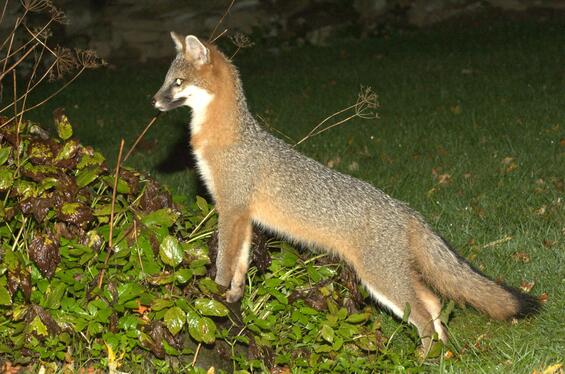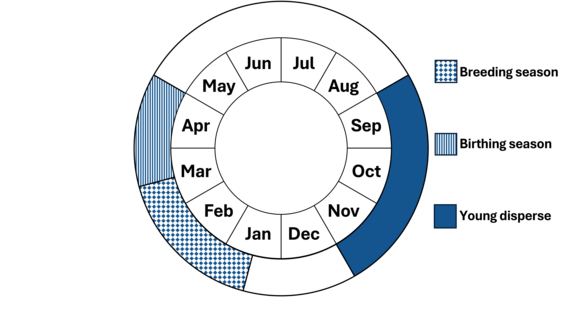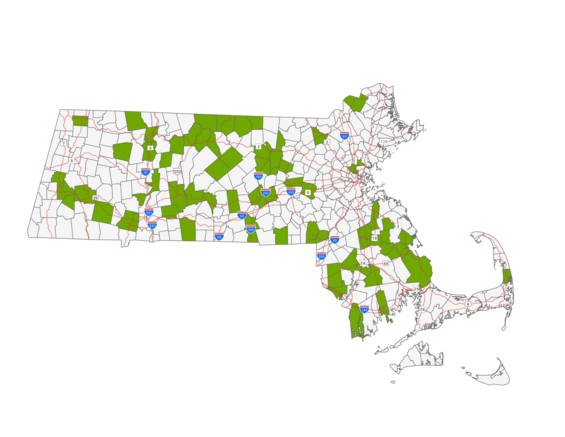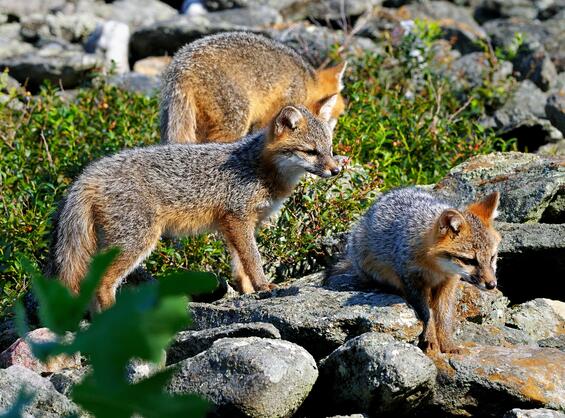- Scientific name: Urocyon cinereoargenteus
- Species of Greatest Conservation Need (MA State Wildlife Action Plan)
Description

Gray fox (Urocyon cinereoargenteus)
Gray fox coloration is overall gray, with the darkest color extending in a stripe along the top of the back down to the end of the tail. They also have rusty-red fur on their ears, ruff, and neck and their belly, throat, and chest are whitish. Compared to the red fox, the gray fox has a shorter muzzle and shorter ears, as well as oval pupils. Adult gray fox measure about 78.7–111.8 cm (31–44 in) in total length, including a 20.3–43.2 cm (8–17 in) tail, and weigh 3.16–5.9 g (7–13 lb).
Life cycle and behavior
Gray foxes are omnivorous and will eat small rodents, squirrels, rabbits, birds, eggs, insects, vegetation, fruit, and carrion. They will cache food when food is plentiful. Gray foxes are one of only two canid species in the world that can climb trees thanks to their hook-shaped claws. They are active year-round and, while they are mostly nocturnal and crepuscular, they can be seen during the day.
Gray foxes form monogamous pairs and breed between January and March. During this time, the foxes begin to prepare dens. These dens are typically a burrow in the earth, 4.6–6.1 m (15–20 ft) long, and are usually located on the side of a knoll, but they may also set up dens in and under buildings, in rock crevices, or even in trees. After a 53-day gestation period, 1–7 kits (3–4 on average) are born in March–April. The young are weaned at 4 months, become independent at 6 months, and disperse from their family unit their first fall.

This graphic represents the peak timing of life events for gray fox in Massachusetts. Variation may occur across individuals and their range.
Population status
Gray fox are widespread and moderately common throughout mainland Massachusetts. They can be found statewide except for Dukes and Nantucket counties but are showing declines in abundance range-wide.

Massachusetts towns with gray fox harvest reports. 2018/19-2022/23. Based on MassWildlife records.
Distribution and abundance
Today, gray fox range from southern Canada to Northern Columbia and Venezuela. They are absent, or nearly so, from Idaho, Montana, Washington, and Wyoming. While gray fox range historically included Massachusetts, it appears as though they disappeared from New England and other eastern North America areas by the mid-1700s. However, the species later recovered and expanded back into the places they were absent or extirpated.
Habitat
Gray fox thrive in dense northern hardwood and mixed forests where they often inhabit thickets, brushy areas, and swamps. They will also utilize suburban and urban areas when human-associated foods are available.
Healthy habitats are vital for supporting native wildlife and plants. Explore habitats and learn about conservation and restoration in Massachusetts.

Threats
Multiple studies have been initiated to evaluate the status of gray fox and determine the causes of range-wide decline. One potential threat is canine distemper virus (CDV). Gray fox are highly susceptible to canine distemper. Recent widespread outbreaks of distemper in raccoons and skunks in Massachusetts indicate that gray fox also may have been impacted. Other potential concerns include secondary rodenticide poisoning, impacts of coyote population expansion, and habitat loss and degradation.
Conservation
MassWildlife is currently participating in a regional study looking at the potential impact of rodenticide on gray fox health and mortality. Other states are collecting public sighting reports of gray foxes or setting out trail cameras to better understand their present-day distribution and abundance. In the midwestern U.S., a study in Illinois found gray fox had a 4-fold decline in occupancy while Indiana conducted a study that suggests a primary cause for the decline in gray fox populations may be canine distemper virus. Results from study in North Carolina indicate that preserving tree cover (at least 50% forest cover in 1 km radius) could be an important factor in avoiding impacts from interactions between gray fox and coyotes.
References
Cardoza, J.E., T.F. French, and G.S. Jones. Mammals of Massachusetts, with reference to other New England States. Northeastern Naturalist, accepted and under review.
Larreur, M., Nielsen, C., Lesmeister, D., Bastille-Rousseau, G. “The precipitous decline of a gray fox population.” Global Ecology and Conservation 58 (2025).
Parson, A., Kellner, K., Rota, C., Schuttler, S., Millspaugh, J. Kays, R. “The effect of urbanization on spatiotemporal interactions between gray foxes and coyotes.” Ecosphere 13, no. 3 (2022).
For more information on gray fox from MassWildlife, see Learn about gray fox.
Contact
| Date published: | May 1, 2025 |
|---|